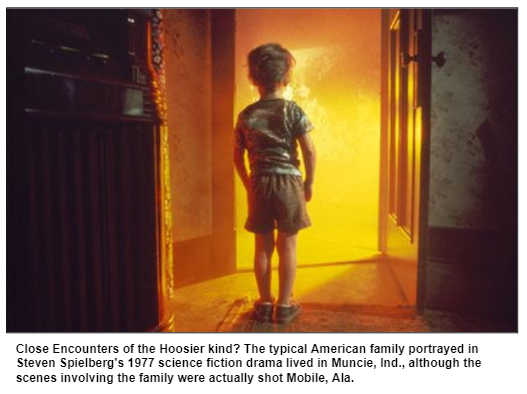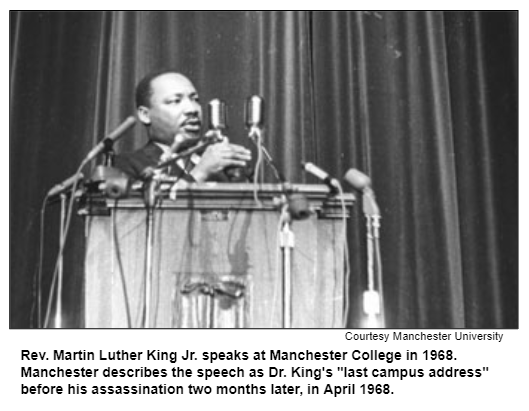
Saturdays, noon to 1 p.m. ET on WICR 88.7 FM.
Or listen live from anywhere on WICR Online!
Our call-in number during the show: (317) 788-3314
January 12, 2019
Movies with obscure Indiana connections
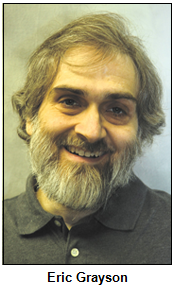 Even though Close Encounters of the Third Kind was considered a blockbuster after its release in 1977, many Hoosiers may have forgotten its connection to Indiana. No scenes were filmed in the state, but the central characters were described as residents of Muncie.
Even though Close Encounters of the Third Kind was considered a blockbuster after its release in 1977, many Hoosiers may have forgotten its connection to Indiana. No scenes were filmed in the state, but the central characters were described as residents of Muncie.
In a scene played for laughs in Brother from Another Planet (1984), the protagonist, an alien who doesn't speak, encounters wide-eyed tourists from Indiana on a subway in New York City.
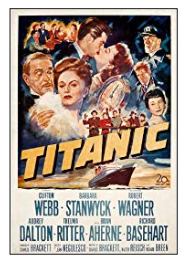
In the 1953 version of the film Titanic, a fictional passenger on the doomed ocean liner is a student at Purdue University. Played by Robert Wagner, the character is described as a college tennis star.
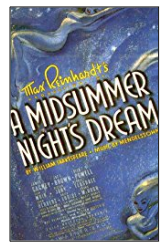
In addition to talking about movies with obscure links to Indiana, during our show Eric will share insights about actors and directors with Hoosier connections who - unlike the more famous James Dean, Steve McQueen, Carole Lombard and other stars - are seldom discussed today.

They include Otis Harlan (1865-1940), a comedian and character actor from Martinsville. According to Eric, Harlan was featured in hundreds of silent movies and early talkies, including a film version of A Midsummer Night's Dream (1935). Harlan also provided the voice of the dwarf Happy in Disney's animated Snow White and the Seven Dwarfs (1937).
Richmond native Norman Foster (1903-1976), an actor who enjoyed greater success when he became a director, also was involved in Disney projects. Foster was associated with Orson Welles for many decades, serving as the director of the spy thriller Journey into Fear (1943) starring Welles, as well as several Charlie Chan mysteries. As an actor, Foster had a major role in Welles' final movie, The Other Side of the Wind, which began filming in 1970; it was uncompleted when Welles died in 1985 and finally was released in 2018 after being reconstructed by other filmmakers.
Both Foster and Harlan were in the cast of The Hoosier Schoolmaster (1935), a movie based on a 19th-century novel by Indiana author Edward Eggleston. The setting is southern Indiana after the Civil War.
History Mystery
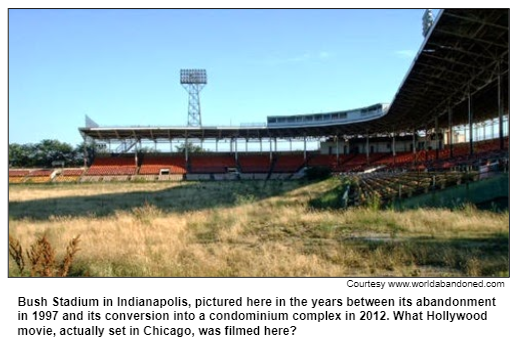
A major Hollywood movie released in 1988 was set in Chicago, but many significant scenes actually had been filmed in Indianapolis during the previous year.
The film's plot focuses on one of the most notorious scandals in baseball history. In 1919, Chicago White Sox players accepted bribes to lose the World Series. The movie, which starred John Cusack and Charlie Sheen, follows the unfolding of what became known as the "Black Sox scandal."
Historic Bush Stadium, still the home of the Indianapolis Indians during the 1980s, was the setting for many of the baseball sequences in the movie, standing in for the home field of the 1919 White Sox.Question: What was the name of the baseball movie filmed at Bush Stadium?
Please do not call in to the show until you hear Nelson pose the question on the air, and please do not try to win if you have won any other prize on WICR during the last two months. You must be willing to give your first name to our engineer, you must answer the question correctly on the air and you must be willing to give your mailing address to our engineer so we can mail the prize pack to you. The prize this week is a dvd of the newly remastered film Little Orphant Annie starring Colleen Moore and restored by Eric Grayson, courtesy of Eric Grayson. Don’t miss this opportunity to win a copy of this cinematic treasure telling the story of a beloved James Whitcomb Riley poem!
Roadtrip: Military history at Fort Harrison State Park

Guest Roadtripper Paul Diebold of the Indiana Department of Natural Resources, Division of Historic Preservation, invites us on a jaunt to Fort Benjamin Harrison State Park (AKA Fort Ben) on the northeast side of Indianapolis to visit the Museum of 20th Century Warfare and other points of interest to fans of military history.
Open year-round in Building 711 of Fort Ben (you can pick up a map at the gate as you enter the park), the museum offers artifacts and displays about mechanized war, including such fascinating objects as a four-foot model of the USS Indianapolis. Also available for viewing: a variety of 20th-century military items donated by veterans.
Once you've explored the museum, Paul suggests that you take a look around other buildings that are part of the Camp Glenn portion of the original fort. Camp Glenn served as a Citizens' Military Training Camp from 1925 to 1941, a camp for the Civilian Conservation Corps from 1933 to 1941, and a prisoner-of-war camp from 1944 to 1945. Camp Glenn is one of only a few surviving POW camps from WWII; to learn more about the history of the camp, take a walking tour offered by the park.
If the weather's good when you visit, you may enjoy strolling around the former parade grounds on Lawton Loop. Officers lived in the homes along the west side, while enlisted men slept in the brick barracks on the east side. And if you work up an appetite from your walk, check out nearby Café Audrey - once the fort's blacksmith shop, where horses were shoed. Speaking of horses (and leading them to drink?), Triton Brewing is located in one of the former horse and mule barns.
To get the low-down on Central Indiana's military history at Fort Benjamin Harrison, be sure to listen for this week's Roadtrip!
Hoosier History Live podcasts are now available for free at the Apple iTunes store!

Those who like to subscribe to podcasts can now find us in the Apple iTunes store as well - at no charge, of course. Just open your iTunes app, click in the search box and search for "Hoosier History Live." We're working to get listed on all the major podcast providers as well; send us an email if your favorite one doesn't carry us, and we'll make sure it gets posted there. We'll keep posting podcast links on our newsletter and website as before. And if you're looking for a podcast from a 2017 or 2018 show, just go to the Archive page on our website and you'll see the podcast link posted right below the show's title.
Thanks to associate producer Mick Armbruster for heading up our online distribution project. Our growing availability as a podcast and on iTunes is great news for our sponsors as well. More media reach!
New to podcasts? All you need is a computer or smartphone, and you can listen to radio shows (and more!) wherever and whenever you want. Confused by the new-fangled technology? Check out this guide to podcasts, provided by Wired Magazine.
Coming Soon: Our 11th anniversary party

The party will be held Thursday, February 28 from 5:00 to 7:30 pm at Indiana Landmarks Center, 1201 N. Central Avenue, Indianapolis, IN 46202.
Come as you are, or (better yet!) dress in historic garb as your favorite character from the past.
More details to come!
Nelson Price, host and historian
Molly Head, producer/project manager, (317) 927-9101
Michael Armbruster, associate producer
Cheryl Lamb, administrative manager
Richard Sullivan, senior tech consultant
Pam Fraizer, graphic designer
Garry Chilluffo, special events consultant
Please tell our sponsors that you appreciate their support!

 Acknowledgments to Monomedia, Visit Indy, WICR-FM, Fraizer Designs, Heritage Photo & Research Services, Henri Pensis, Aaron Duvall, and many other individuals and organizations. We are an independently produced program and are self-supporting through organizational sponsorship, and by individual contribution at the yellow button on our newsletter or website. For organizational sponsorship, which includes logos, links, and credits in the show, contact Molly Head at (317) 927-9101 or email her at molly@hoosierhistorylive.org. And any of our podcasts can be sponsored for a nominal fee.
Acknowledgments to Monomedia, Visit Indy, WICR-FM, Fraizer Designs, Heritage Photo & Research Services, Henri Pensis, Aaron Duvall, and many other individuals and organizations. We are an independently produced program and are self-supporting through organizational sponsorship, and by individual contribution at the yellow button on our newsletter or website. For organizational sponsorship, which includes logos, links, and credits in the show, contact Molly Head at (317) 927-9101 or email her at molly@hoosierhistorylive.org. And any of our podcasts can be sponsored for a nominal fee.
Thank you!
We'd like to thank the following recent, new and renewal contributors whose donations help make this show possible!
- Bill McNiece
- Tom Spalding
- Joseph Leak
- Melissa Martin
- Diane Dallis
- Yetta Wolen
January 12, 2019 - coming up
Rev. Martin Luther King Jr. visits to Indiana
Both before he became a household name nationally and after he was a famous public figure, Rev. Martin Luther King Jr. made trips to Indiana. How those visits during the 1950s and '60s unfolded, where Rev. King stayed and other details, will be the focus of our show two days prior to Dr. Martin Luther King Jr. Day.

Nearly 10 years earlier, in 1958 when he was a young minister and civil rights leader in the South, 29-year-old Dr. King spoke in downtown Indianapolis at Cadle Tabernacle, a sprawling, Spanish-style structure that served as the site of conventions, religious gatherings, music concerts and a range of other events. Cadle Tabernacle, which was located at Ohio and New Jersey Streets, was demolished during the late 1960s.
In the decade between that speech and the talk at Manchester College near the end of his life, Dr. King periodically visited Indianapolis, often staying with the family of his close friend Rev. Andrew J. Brown (1921-1996), pastor of St. John's Missionary Baptist Church. Rev. Brown, one of Indiana's most prominent civil rights leaders of the era, marched with Dr. King in Selma, Ala., in 1965.
For our exploration of Dr. King's trips to Indiana - which also included a speech at Goshen College in 1960 - our studio guests will be:
- Rev. Thomas Brown, a professor at Martin University, radio host on WTLC-FM (106.7) and the son of Rev. Andrew Brown. Because of the friendship between his father and Dr. King - as well as Rev. Thomas Brown's own civil rights work in Selma - he got to know Dr. King on a personal basis. Rev. Thomas Brown is the retired pastor of Ebenezer Missionary Baptist Church.
- Historian David Leander Williams, an adjunct professor at IUPUI. David has been a previous guest on Hoosier History Live when we have explored aspects of African-American history, including the jazz music scene that flourished along Indiana Avenue during the mid-20th Century. David is the author of a new book, Indianapolis Rhythm and Blues (Arcadia Publishing).
- And Susan Hall-Dotson, coordinator of African-American history for the Indiana Historical Society. Susan will discuss Dr. King's visits and related topics during a day-long series of events Jan. 21 at the Indiana History Center in Indianapolis to celebrate MLK Jr. Day.
Accounts about Dr. King's speech at Goshen College, which is affiliated with the Mennonite Church, describe it a "spellbinding lecture." The speech, which he delivered in 1960, occurred about one year after he had traveled to India to study Gandhi's techniques of nonviolence.
At Goshen College, Dr. King discussed nonviolence. He also called on religious leaders to more strongly advocate for civil rights; Dr. King described most churches across the country as "segregated islands."
© 2019 Hoosier History Live. All rights reserved.
|
